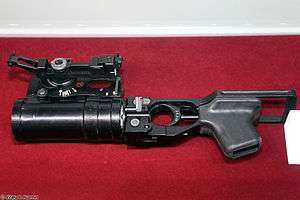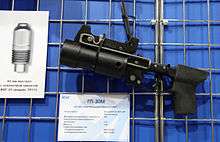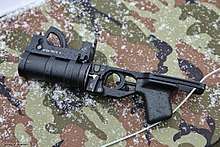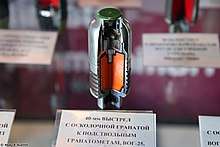GP-25
The GP-25 Kostyor ("Bonfire"), GP-30 Obuvka ("Footwear") and GP-34 are a family of Russian 40 mm under-barrel grenade launchers (Granatomyot Podstvolnyj) for the AK family of assault rifles. They were first seen by the west in 1984 during the Soviet Invasion of Afghanistan. The GP-30 was lightened and the redesigned sighting system was moved to the right.
| GP-25 grenade launcher | |
|---|---|
 40 mm under barrel grenade launcher GP-25 | |
| Type | Grenade launcher |
| Place of origin | Soviet Union |
| Service history | |
| In service | 1978–present |
| Used by | See Users |
| Wars | War in Afghanistan Soviet–Afghan War Transnistria war First Chechen war Second Chechen War Russo-Georgian War Syrian Civil War War in Donbass[1] Yemeni Civil War (2015–present) Saudi Arabian-led intervention in Yemen Saudi–Yemeni border conflict (2015–present) |
| Production history | |
| Designer | TsKIB SOO |
| Designed | 1966–1978 |
| Manufacturer | Kalashnikov Concern STC Delta Arsenal AD Zastava Arms |
| Produced | 1978–present |
| Variants | GP-30, GP-34 |
| Specifications | |
| Mass | 1.5 kg (3.31 lb) (GP-25) 1.3 kg (2.9 lb) (GP-30) 1.4 kg (3.1 lb) (GP-34)[2] |
| Length | 323 mm (12.7 in) (GP-25) 275 mm (10.8 in) (GP-30) 315 mm (12.4 in) (GP-34)[2] |
| Barrel length | 120 mm (4.7 in) |
| Cartridge | 40mm caseless grenade |
| Caliber | 40 mm |
| Action | Single-shot |
| Rate of fire | 20 rounds/min area suppression[2] 5–6 rounds/min aimed shots[2] |
| Muzzle velocity | 76.5 m/s (251 ft/s)[2] |
| Effective firing range | Sights adjustable 100 to 400 meters[2] |
| Feed system | Muzzle loaded, single-shot |
| Sights | Notched quadrant sight |
The current Izhmash-made version, the GP-34, has an again redesigned sighting system on the right and features the following advantages:
- Reliability: It is designed and tested specifically for the Kalashnikov assault rifles, fits such assault rifles directly without any adaptors or forearm dismantling.[2]
- Improved safety: The design prevents a round from moving within or falling out of the barrel, even if the muzzle is pointed down. The GP-34 features an additional mechanism (firing pin safety lever) to improve safety during loading.[2]
Development




Development of a grenade launcher for the AK-47 assault rifle began in 1966 at the Sporting and Hunting Arms Central Design and Research Bureau. Development continued into the 1970s, and in 1978 it was accepted into service. The GP-30 first entered service in 1989, and is intended for use with the AK-100 series of assault rifles. The GP-34 is designed to be a universal service model that can be fitted to the AKM / AKMS, AK74 / AK74S, AK74M, AK-101, AK-103, and AN-94 rifles.
Description
The grenade launchers are similar in appearance and fire the same 40 mm caliber ammunition and use the same High-Low System developed by Germany in late World War II to keep recoil forces low without a rocket or other type of recoilless weapon back blast.
The GP-30(M) is a stripped-down model grenade launcher, consisting of a very short, 40 mm rifled barrel in front of a basic trigger mechanism with minimal hand grip. On top of the barrel is mounting gear to attach the weapon under the barrel of an AK-series assault rifle, from where it is designed to be fired.
A grenade is first muzzle loaded into the barrel, the weapon is aimed, then the self-cocking trigger is pulled to fire the weapon. This fires the percussion cap at the base of the grenade which triggers the nitrocellulose propellant inside the body of the grenade. The hot expanding gas from the propellant is forced through vents in the base of the grenade that move the grenade along the barrel, and at the same time force the driving band to engage with the twelve rifling grooves. The rifling imparts stabilizing spin to the projectile.
The barrel has a service life of about 400 rounds.
Ammunition
The grenade launchers fire a series of special 40 mm grenades. Originally, the main grenade was the VOG-15 (7P17) fragmentation grenade. This was superseded by the steel-cased VOG-25 fragmentation grenade. The VOG-25 has a lethal radius of six meters. Rounds for the muzzle-loaded GP-25 consist of a single piece containing both propellant and warhead, unlike the more traditional two piece casing-and-projectile design of the comparable American 40x46mm round used in breech-loaded grenade launchers, such as the M203.
A bouncing grenade, the VOG-25P, is also available. On impact, a small charge in the nose of the grenade is detonated; this raises the grenade 0.5 to 1.5 m in the air, before an impact delay fuse detonates it. The VOG-25P also has a lethal radius of six meters.
New generation rounds VOG-M and VOG-PM with an increased effectiveness not less than 1.5 times are now serially available.[3]
Smoke grenades are also available. The original GRD-40 grenade has been replaced by a series of grenades designed for use at different ranges. These are the GRD-50, GRD-100 and GRD-200 for use at 50, 100 and 200 meters respectively. They are capable of producing a 20 square meter cloud of smoke that lasts for one minute in winds of up to five meters per second.
A CS gas grenade called the Gvozd ("Nail") and a baton grenade are also available.
Grenades

- Fuse arming range: 10–40 m (33–130 ft)
- Fuse self-destruction time: 14–19 s
- VOG-25 specifications:
- Weight: 250 g (0.55 lb)
- Warhead: 48 g of A-IX-1 explosive.
- VOG-25P specifications:
- Weight: 278 g (0.61 lb)
- Warhead: 37 g of TNT.
- GRD-50/100/200 specifications
- Weight: 265 g
- Warhead: 90 g
Variants
- GP-25 Kostyor
- GP-30 Obuvka
- GP-34
Users


















See also
- BS-1 Tishina
- QLG-10
- RGM-40 Kastet grenade launcher is a stand-alone version of GP-30 grenade launcher
- Wz. 1974 Pallad grenade launcher
References
- "Archived copy". Archived from the original on 2018-10-18. Retrieved 2017-09-14.CS1 maint: archived copy as title (link)
- "Archived copy". Archived from the original on 2012-07-28. Retrieved 2012-10-20.CS1 maint: archived copy as title (link) |Izhmash GP-34 Specifications
- https://translate.google.pl/translate?sl=auto&tl=en&js=y&prev=_t&hl=pl&ie=UTF-8&u=https%3A%2F%2Fria.ru%2Finterview%2F20161110%2F1481076567.html&edit-text=&act=url
- "Archived copy". Archived from the original on 2016-11-24. Retrieved 2017-09-14.CS1 maint: archived copy as title (link)
- Arsenal Corporation. "Arsenal 40 mm Underbarrel Grenade Launcher UBGL". Archived from the original on 8 October 2014. Retrieved 15 November 2014.
- Arsenal Corporation. "Arsenal 40 mm Underbarrel Grenade Launcher UBGL-1". Archived from the original on 29 November 2014. Retrieved 15 November 2014.
- Thierry Vircoulon (2014-10-02). "Insights from the Burundian Crisis (I): An Army Divided and Losing its Way". International Crisis Group. Archived from the original on 2017-05-21. Retrieved 2017-06-12.
- STC Delta. "40 mm under barrel grenade launcher GP-25". Archived from the original on 13 June 2015. Retrieved 15 November 2014.
- "Industrial Parade". Archived from the original on 7 January 2014. Retrieved 6 June 2013.
- "Lietuvos kariuomenė :: Ginkluotė ir karinė technika » Granatsvaidžiai ir prieštankiniai ginklai". Archived from the original on 9 November 2014. Retrieved 15 November 2014.
- Jones, Richard D. Jane's Infantry Weapons 2009/2010. Jane's Information Group; 35 edition (January 27, 2009). ISBN 978-0-7106-2869-5.
- "Archived copy" (PDF). Archived (PDF) from the original on 2016-03-04. Retrieved 2015-04-04.CS1 maint: archived copy as title (link)
- Zastava Arms. "Underbarrel grenade launcher PBG-40 mm". Archived from the original on 27 October 2014. Retrieved 15 November 2014.
- Zastava Arms. "Underbarrel grenade launcher PBG 40 mm M70". Archived from the original on 28 October 2014. Retrieved 15 November 2014.
- https://www.bellingcat.com/news/mena/2015/02/19/from-russia-with-love-syrias-ak-74ms/
Koll, Christian (2009). Soviet Cannon – A Comprehensive Study of Soviet Arms and Ammunition in Calibres 12.7mm to 57mm. Austria: Koll. p. 397. ISBN 978-3-200-01445-9.
External links
| Wikimedia Commons has media related to GP-25. |
| Wikimedia Commons has media related to GP-30. |
| Wikimedia Commons has media related to GP-34. |